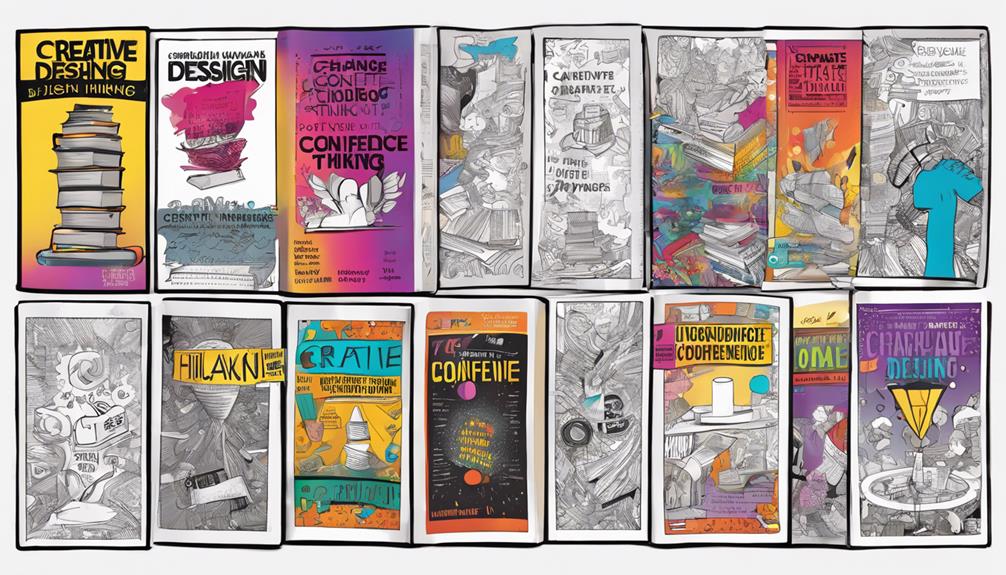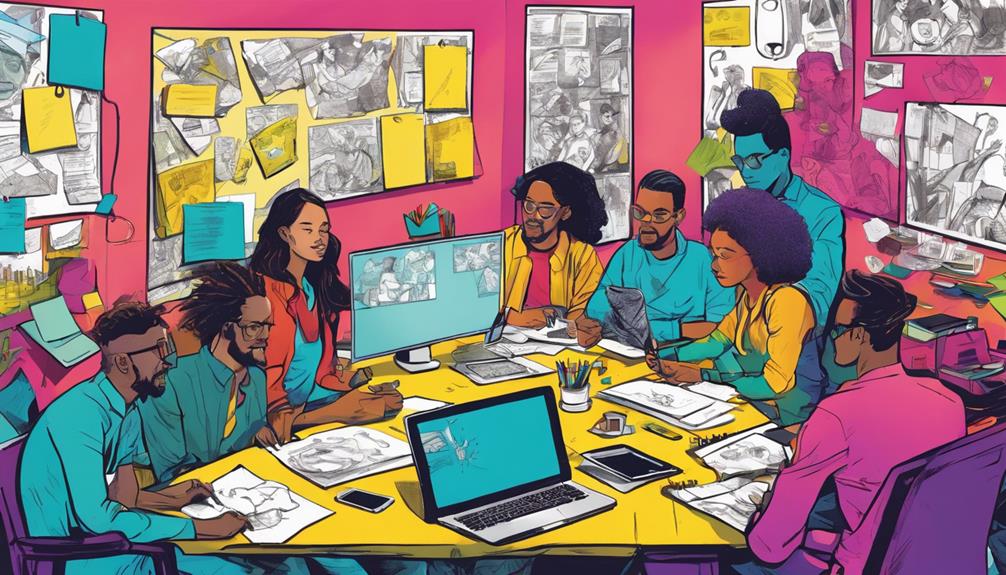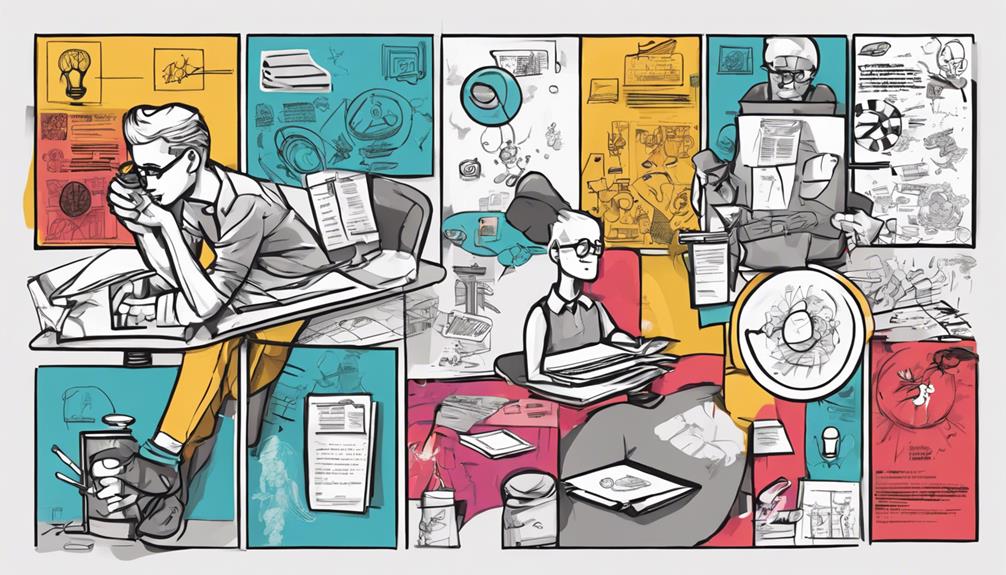For any innovator keen to immerse in design thinking, here are top picks: 'Change by Design' for organizational shifts, 'Creative Confidence' for sparking innovation, 'Lean UX' for efficient idea testing, 'Sensemaking' for exploring the digital sphere, and 'This is Service Design Thinking' for practical service design lessons. These books hold transformative insights to fuel your creativity and enhance problem-solving skills. Ready to open up your potential and embrace new strategies?
Key Takeaways
- "Change by Design" by Tim Brown for organizational transformation through design thinking.
- "Creative Confidence" by Tom and David Kelley to unlock creative potential for innovation.
- "Lean UX" by Jeff Gothelf for efficient testing of new ideas.
- "Sensemaking" by Christian Madsbjerg explores designing for the digital world.
- "This is Service Design Thinking" by Stickdorn and Schneider provides real-life service design examples.
Key Design Thinking Books
If you're searching for essential reading on design thinking, these key books are highly recommended for every innovator.
'Change by Design' by Tim Brown emphasizes how utilizing design thinking transforms organizations, providing insight into tackling significant problems.
Another must-read is 'This is Service Design Thinking' by Marc Stickdorn and Jakob Schneider, which offers real-life examples and best practices for service design thinking.
'Creative Confidence' by Tom and David Kelley is a go-to innovation guide for creative leaders, encouraging the exploration of new ideas.
'Lean UX' by Jeff Gothelf delves into utilizing design thinking to test new ideas efficiently, making it an indispensable resource for those looking to innovate.
Lastly, 'Sensemaking' by Christian Madsbjerg explores how to design for a digital world, offering valuable perspectives on human intelligence in today's technology-driven age.
These books collectively provide a solid foundation for anyone looking to excel in the domain of design thinking.
Must-Read Design Thinking Guides

Explore these must-read design thinking guides to enhance your innovation skills and knowledge base.
- *Change by Design* by Tim Brown: Transform organizations through design thinking.
- *Creative Confidence* by Tom and David Kelley: Unleash creative potential for innovation.
- *Lean UX* by Jeff Gothelf: Apply lean principles to enhance user experience.
- *Sensemaking* by Christian Madsbjerg: Explore human intelligence in problem-solving.
- *This is Service Design Thinking* by Marc Stickdorn and Jakob Schneider: Learn from real-life examples for better understanding of design thinking.
These books cover a wide range of topics including creativity, innovation, user experience, problem-solving, and design thinking methodologies.
By delving into these guides, you can gain valuable insights into how design thinking can be applied effectively in various contexts to drive meaningful change and create innovative solutions.
Whether you're a beginner or an experienced innovator, these resources will help you sharpen your creative skills and navigate the complexities of modern design challenges.
Essential Design Thinking Resources

Discover key design thinking concepts, implement design strategies effectively, and drive innovation through design with essential resources.
These points will provide you with a solid foundation to understand and apply design thinking principles in your projects and organizations.
Key Design Thinking Concepts
In grasping the essence of design thinking, understanding key concepts such as synthesis and user-centricity is essential for innovators seeking to drive impactful solutions.
Plunge into these fundamental design thinking concepts to enhance your problem-solving skills:
- User-Centric Solutions: Prioritizing the needs and experiences of users throughout the design process.
- Empathy: Developing a deep understanding of users' perspectives, emotions, and challenges.
- Iteration: Continuously refining and improving solutions based on feedback and testing.
- Synthesis: Combining diverse observations and data to extract meaningful insights.
- Deductive, Inductive, Abductive Thinking: Leveraging different thinking approaches to generate innovative solutions.
Implementing Design Strategies
Access the potential of design thinking through essential resources that offer practical guidance and tools for implementing innovative strategies across diverse industries.
Books like 'The Design Thinking Playbook' and 'The Design Thinking Toolbox' provide practical guides and toolkits to help you effectively implement design strategies. They offer valuable insights on creative collaboration, teamwork, and risk-taking essential for fostering innovation.
Additionally, 'Designing for People' underscores the significance of design responsibility and public service in design thinking applications, promoting a holistic approach to problem-solving. 'Make Space' explores altering environments to enhance creative collaboration within teams, while 'Building a Greenhouse for Innovation' focuses on creating a culture that embraces risk-taking to drive innovation.
Don Norman's 'The Design of Everyday Things: Revised and Expanded Edition' reinforces good design practices by emphasizing usability, aesthetics, and key principles for designing everyday objects.
Driving Innovation Through Design
Explore important design thinking resources that drive innovation through practical insights and methodologies. Design thinking is vital for driving innovation, emphasizing human-centered design, collaboration, and enhancing user experience.
To effectively implement design thinking and foster innovation, consider the following key resources:
- 'Change by Design' by Tim Brown: Offers valuable insights into the principles of design thinking and driving innovation.
- 'The Design of Everyday Things' by Don Norman: Emphasizes the importance of user-centered design in the innovation process.
- 'The Design Thinking Playbook': Provides practical tools and methodologies for implementing design thinking within organizations.
- 'Designing for Growth': Offers strategies for driving innovation through design thinking principles.
- Embracing Empathy, Iteration, and Experimentation: Vital principles for creating user-centric solutions and gaining a competitive advantage through innovative practices.
Top Design Thinking Recommendations

Discover some of the top design thinking recommendations that can inspire and guide your innovative journey.
'Creative Confidence' by Tom and David Kelley focuses on unlocking creative potential in daily life, emphasizing the importance of human-centered design and creativity.
Tim Brown's 'Change by Design' offers a step-by-step guide on how design thinking transforms organizations, making it a must-read for those interested in driving innovation.
If you're looking to enhance user experience through collaboration and feedback, 'Lean UX' by Jeff Gothelf provides valuable insights on problem-solving in the digital domain.
For a deeper exploration into understanding human intelligence and the impact of algorithms, 'Sensemaking' by Christian Madsbjerg advocates for a humanities-based approach to design thinking.
Lastly, 'This is Service Design Thinking' by Marc Stickdorn and Jakob Schneider offers practical tools and real-life examples for mastering service design concepts.
These books cover a wide array of topics essential for anyone looking to excel in the world of design thinking.
Design Thinking Book Essentials

If you're searching for top design thinking picks, consider these essential reads that have been highly rated and reviewed.
These books provide valuable insights into sparking creativity, transforming organizations, enhancing user experience, and understanding human intelligence in the digital age.
Add these titles to your reading list for a solid foundation in design thinking principles.
Top Design Thinking Picks
Explore the essential design thinking books that every innovator should have on their shelf.
- *'Creative Confidence'* by Tom and David Kelley – Unleash creative potential.
- 'Change by Design' by Tim Brown – Tackle innovative challenges with step-by-step guidance.
- 'Lean UX' by Jeff Gothelf – Enhance user experience using lean principles.
- 'Sensemaking' by Christian Madsbjerg – Plunge into human intelligence amidst technological advancements.
- 'This is Service Design Thinking' by Marc Stickdorn – Learn from real-life examples in service design.
These top design thinking picks cover a wide array of topics essential for fostering innovation. From boosting creative confidence to understanding user experience, these books offer valuable insights into unleashing your creative potential, navigating through innovative challenges, and integrating lean principles.
Immerse yourself in the domains of human intelligence, service design, and more, all while gaining practical knowledge from real-world examples. Whether you're new to design thinking or looking to deepen your understanding, these books are sure to inspire and equip you for your innovation journey.
Essential Reading List
The essential reading list for design thinking enthusiasts includes highly rated books that cover various aspects of innovation and creativity.
Discover new ways to unlock your creative potential with 'Creative Confidence' by Tom and David Kelley.
Plunge into the transformative power of design thinking in organizations with 'Change by Design' by Tim Brown.
Learn how to enhance user experience by applying lean principles in 'Lean UX' by Jeff Gothelf.
Explore human intelligence amidst the rise of algorithms in 'Sensemaking' by Christian Madsbjerg.
For those interested in service design, 'This is Service Design Thinking' by Marc Stickdorn and Jakob Schneider provides essential insights into the process of designing services.
These books can help leaders in business and beyond to work smarter, understand their customers better, and drive innovation in the ever-evolving landscape of design thinking.
Recommended Design Thinking Reads

Discover these highly recommended design thinking books that can fuel your innovation journey.
- *'Creative Confidence' by Tom and David Kelley*: Exhibit your creative potential with practical advice on the creative process.
- *'Change by Design' by Tim Brown*: Navigate innovation challenges with a step-by-step guide to the design thinking process.
- *'Lean UX' by Jeff Gothelf*: Learn about applying lean principles to enhance user experience and innovation outcomes.
- *'Sensemaking' by Christian Madsbjerg*: Explore human intelligence in the modern age, infusing design thinking with deep insights.
- *'This is Service Design Thinking' by Marc Stickdorn and Jakob Schneider*: Gain real-life examples and strategies for better understanding the creative process.
These design thinking reads cater to creative leaders seeking to infuse design thinking into their organizations, providing valuable insights into revealing creative potential and overcoming innovation hurdles.
Whether you're new to design thinking or looking to deepen your understanding, these books offer practical advice and inspiration to drive your innovation endeavors forward.
Design Thinking Masterpieces

Reveal the brilliance of these design thinking masterpieces that have captivated innovators worldwide. Immerse yourself in these transformative books that focus on unleashing creative potential, transforming organizations, applying lean principles, exploring human intelligence, providing real-life examples for better understanding, and enhancing innovation and user experience.
| Design Thinking Books | Key Focus | Rating & Reviews |
|---|---|---|
| 'Creative Confidence' by Tom and David Kelley | Unleashing Creative Potential | 4.2 with 196 reviews |
| 'Change by Design' by Tim Brown | Transformation of Organizations | 4.2 with 165 reviews |
| 'Lean UX' by Jeff Gothelf | Applying Lean Principles | 4.2 with 140 reviews |
| 'Sensemaking' by Christian Madsbjerg | Insights into Human Intelligence | 4.1 with 27 reviews |
| 'This is Service Design Thinking' by Marc Stickdorn and Jakob Schneider | Practical Examples for Better Understanding | 4.2 with 134 reviews |
These masterpieces offer profound insights into the world of design thinking, providing invaluable knowledge and tools for innovators looking to make a significant impact in their respective fields.
Design Thinking Literature Highlights

Explore the impactful narratives and insights found within the domain of design thinking literature highlights. Plunge into these must-read books that offer a wealth of knowledge on innovative problem-solving, infusing design thinking, and creating big ideas:
- *'Creative Confidence'* by Tom and David Kelley – Inspiring creative confidence and unlocking your creative potential.
- 'Change by Design' by Tim Brown – Demonstrating how design thinking transforms organizations.
- 'Lean UX' by Jeff Gothelf – Applying lean principles to enhance user experience.
- 'Sensemaking' by Christian Madsbjerg – Exploring human intelligence in the era of algorithms.
- 'This is Service Design Thinking' by Marc Stickdorn and Jakob Schneider – Providing a foundation in service design basics, tools, and real-world cases.
These literature highlights offer invaluable insights into human-centered design, innovation in companies, and equipping design thinkers with the necessary tools to propel change and success through design thinking principles.
Frequently Asked Questions
What Is One Successful Method of Design Thinking Used to Generate Innovative Ideas?
To generate innovative ideas in design thinking, try mind mapping. It's a powerful method that sparks creativity and helps you visualize connections. Start by jotting down your central idea and branching out with related concepts.
Who Is the Father of Innovation and Design Thinking?
Imagine a seed from which innovation blossoms—Roger L. Martin, the father of innovation and design thinking. His pioneering work emphasizes user-centric solutions, driving businesses to adopt design thinking for a competitive edge.
Can Design Thinking Be Used for Innovation?
Yes, design thinking can definitely be used for innovation. It focuses on user-centric solutions, fosters creativity, and drives customer-centric solutions. The process includes stages like empathizing, defining, ideating, prototyping, and testing, all essential for innovation.
What Is a Design Thinking Book?
To understand what a design thinking book is, immerse yourself in resources offering methodologies, strategies, and real-world examples. These books cater to innovators, designers, and business leaders, providing step-by-step guides for fostering creativity and user-centered solutions.
Conclusion
So there you have it, the best design thinking books for your journey as an innovator.
Remember, the world is your oyster, and these resources are your pearls.
Keep exploring, keep learning, and keep pushing the boundaries of creativity.
The sky's the limit when it comes to design thinking, so go forth and conquer with these invaluable tools at your disposal.









